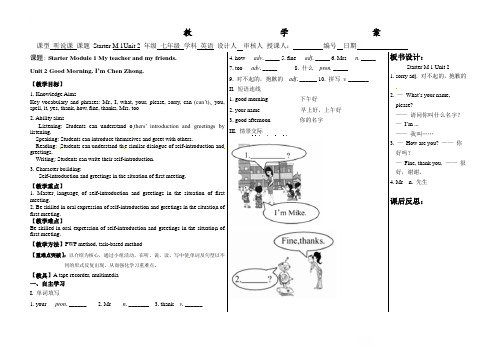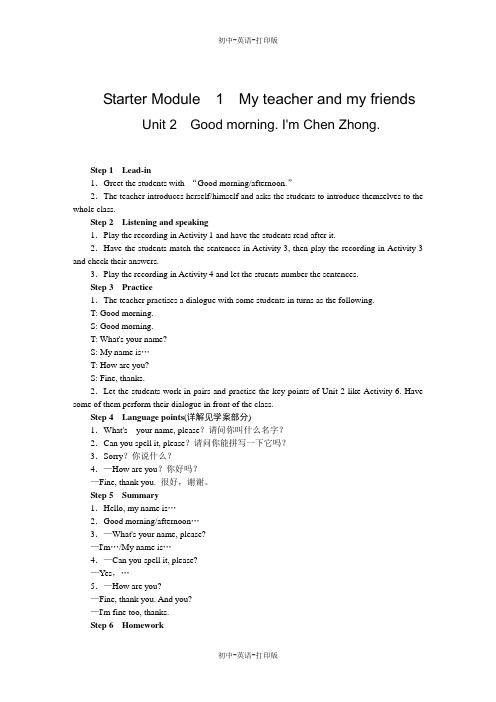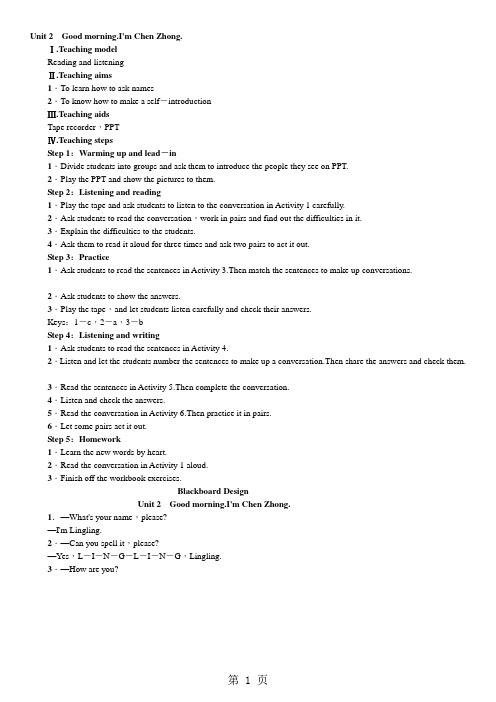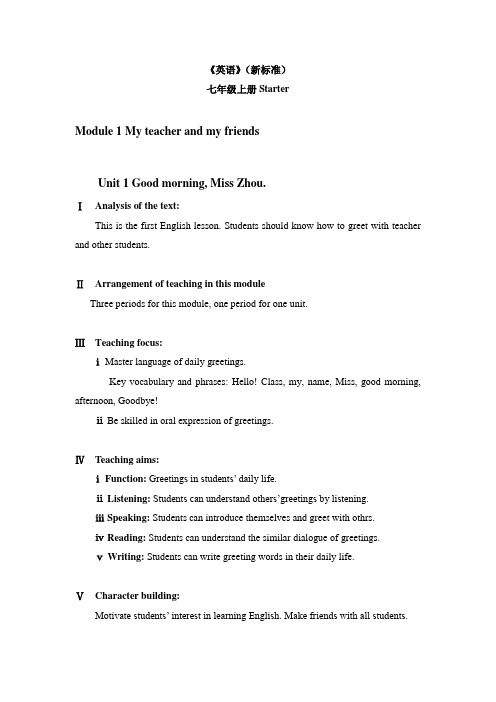外研版七年级上册英语教案:Starter Module1Unit2 Good morning. I’m Chen Zhong
外研版七年级英语(上)Starter Module1 Unit1教案

俎店镇中心初级中学英语组第一周课时教案2015 年 9 月 7 日第 1 节总第1课时课题Starter Module1 Unit1备课人课型Listening andspeaking课时 1教学目标知识与能力学习称呼语和问候语Key vocabulary and phrases: Hello! Class, my, name, Miss, goodmorning, afternoon, Goodbye!Be able to write the letters correctly.过程与方法通过学习基本的英语问候语,试着用英语进行自我介绍并介绍他人情感态度价值观能对老师和同学致以简单的问候,并乐于用英语交流。
课标要求能在课堂活动中用简短的英语进行交际重点打招呼用语难点如何正确运用打招呼用语教法Listening andspeaking教具学具白板录音机教学程序教师活动学生活动1.Greeting.2.Warming-upT: Class,Please stand up. Hello, class. S: Hello, Mr Wu.T: Sit down ,please.S: Thank you.At the same time,introduce myself. And then ask the students to introduce themselves in groups.3.DrillsAsk the students to practice in groups(1)练习打招呼问好。
(2)练习感谢他人。
(3)练习告别语Goodbye。
Greeting.Practice PracticeWrite the letters4.PractiseWork in e to Part7. If necessary help the students .Pay attention to how to write the letters d / f / i / k / y / p / q5.ConcludeAsk the students to sum up the points have learnt in the lesson.6.HomeworkPractice writing the letters. Do more writing Sum up the points板书设计Good morning. Good afternoon. Goodbye. Hello,my name's ...教学反思初次上课学生激情非常高,但是书写水平不高,急需大量练习。
外研版七年级英语上册Starter Module 1教案

Unit 1 Good morning!一.Unit 1的教学重点:Aa----Hh的字母教学相互问候:Good morning/afternoon/evening, Alice!Hello, Frank!Hi, Cindy! How are you?I’m fine/OK, thanks.二.教学难点:a) 不同时间的不同问候;b) 人名的读法和人物与名字的配对(8个)。
整个单元的内容,我把它分配在3个课时中完成。
第一课时:完成Section A----1a,1b。
课时目标:a) 学习见面时的相互问候。
b) 认识1a中的8个人物,能正确读出他们的名字。
第二课时:完成Section A----2a,2b,2c,2d,3,4a,4b,4c。
课时目标:a) 学习字母Aa----Hh。
b) 了解一些英语缩略词的意思。
c) 巩固上一课时中所学的人名及不同时间的问候。
第三课时:完成Section B 1, 2a, 2b, 3a, 3b, 4, 5;Self Check 1, 2, 3, 4。
课时目标:a) 学习将相同元音音素的字母和单词归类(A/ei/, /æ/, E/i:/, /e/)。
b) 巩固本单元的字母、单词和句型。
c) 培养自我检测能力以及名字卡片的建立。
三、教学目标A、语言知识目标1、词汇:Letters Aa---Hhhi、hello、good、morning、afternoon、evening、fine、OK、thanks2、句型: Good morning/afternoon/evening, Alice!Hello, Frank!Hi, Cindy! How are you?I’m fine/OK, thanks.B、语言技能目标本单元要求学生掌握英文字母Aa—Hh,能认读其印刷体和手写体字母的大小写等四种形式;能看, 听,说本单元所列的日常交际用语,重点学会打招呼,并做到语音语调正确。
外研版七年级英语上册教案Starter Module 1 Unit 2

Unit 2 Good morning. I’m Chen Zhong.
环节1 新课导入
课前播放小学阶段学过的歌曲Hello和Good morning渲染气氛,同时复习上一节课学过的句型。
设计意图:通过歌曲引起学生学习英语的兴趣,同时让学生巩固对已学知识的掌握。
环节2
1. 教师播放录音,让学生认真听并跟读,关注语音语调。
2. 教师再次播放录音,让学生逐句跟读模仿。
3. 学生两人一组,练习朗读对话。
4. 邀请两三位学生当堂表演。
5. 学生个体活动,完成匹配练习。
6. 教师播放录音并核对答案。
7. 教师播放录音,让学生排序。
8. 全班核对答案,教师点名,部分同学朗读。
9. 学生个体活动,教师巡视。
10. 教师播放录音,学生核对答案。
11. 对于普遍问题,教师在全班进行点评。
12. 教师向学生说明活动形式及要求。
13. 学生两人一组进行问候和自我介绍。
板书设计
练习设计
请完成本课对应训练!。
外研版七年级英语上册StarterModule1Unit2教学案

教学案课型听说课课题Starter M 1Unit 2年级七年级学科英语设计人审核人授课人:编号日期课题:Starter Module 1 My teacher and my friends.Unit 2 Good Morning. I’m Chen Zhong.【教学目标】1. Knowledge AimsKey vocabulary and phrases: Mr., I, what, your, please, sorry, can (can’t),you, spell, it, yes, thank, how, fine, thanks, Mrs. too2. Ability aimsListening: Students can understand o thers’ introduction and greetings by listening.Speaking: Students can introduce themselves and greet with others. Reading: Students can understand the similar dialogue of self-introduction and greetings.Writing: Students can write their self-introduction.3. Character building:Self-introduction and greetings in the situation of first meeting.【教学重点】1. Master language of self-introduction and greetings in the situation of first meeting.2. Be skilled in oral expression of self-introduction and greetings in the situation of first meeting.【教学难点】Be skilled in oral expression of self-introduction and greetings in the situation of first meeting.【教学方法】PWP method, task-based method【重难点突破】:以介绍为核心,通过小组活动,在听、说、读、写中使单词及句型以不同的形式反复出现,从而强化学习重难点。
外研版新标准七年级英语上册Starter Module 1 Unit 2 Good morning. I’m Chen Zhong教学设计

New words:
what your is can spell thank how you
New expressions:
1. —Wh—I’m…
2. —How are you?
—I’m fine, thank you .And you?
—I’m fine. thanks.
学生活动
Listen and read and write down
目的
以旧引新,激发学生的兴趣。
Pre-reading
教师活动
创设情境,学习部分新单词what, your, is, can, spell, thank, how, you
学生活动
学生根据情境,说对话
目的
展示对话动画,模仿,演说
While-reading
—I’m fine. thanks.
2. —Can you spell it?
—Yes, L-I-N-G-L-I-N-G.
学生活动
Students read, sum up and write
目的
见面打招呼,学习礼仪举止。
Homework
Read and recite
Blackboard
arrangement
外研版新标准七年级英语上册Starter Module 1 Unit 2 Good morning. I’m Chen Zhong教学设计
教
学
目
标
知识目标
Grasp the new words: what, your, please, sorry, can, you, spell, thank, how, fine, too.
3. —Can you spell it?
新外研英语七年级上 Starter 部分 《Module1 Unit1 》教学设计

新外研英语七年级上 Starter 部分《Module1 Unit1 》教学设计一. 教材分析《新外研英语》七年级上册Starter部分《Module1 Unit1》主要介绍了日常生活中的基本问候语和介绍自己的方式。
本单元包括三个主要句子:“Hello, my name is…”“Good morning/afternoon/evening, my name is…”“Nice to meet you.”以及一个常用表达:“How are you?”本单元的教学目标是让学生掌握基本的日常英语问候和自我介绍,并能够运用到实际生活中。
二. 学情分析七年级的学生刚开始接触英语,对于大部分学生来说,英语是一门全新的学科。
因此,学生在学习过程中需要逐步建立对英语的兴趣和信心。
在《Module1 Unit1》的教学中,学生需要掌握基本的日常英语问候和自我介绍,为以后的学习打下基础。
三. 教学目标1.知识目标:学生能够掌握基本的日常英语问候和自我介绍,如“Hello,my name is…”“Good morning/afternoon/evening, my name is…”“Nice to meet you.”以及“How are you?”2.能力目标:学生能够听、说、读、写这些问候和自我介绍的表达,并在实际生活中运用。
3.情感目标:通过学习英语问候和自我介绍,学生能够更加自信地面对新的学习环境,建立良好的同学关系。
四. 教学重难点1.重点:学生能够掌握基本的日常英语问候和自我介绍。
2.难点:学生能够正确地发音和运用这些问候和自我介绍的表达。
五. 教学方法1.任务型教学法:通过设定各种实际情境,让学生在完成任务的过程中运用所学知识。
2.情境教学法:创造真实的语言环境,让学生在实际情境中学习英语。
3.交互式教学法:引导学生相互交流、互动,提高学生的参与度和积极性。
六. 教学准备1.教师准备:熟悉教材内容,了解学生的学习情况,设计教学活动和作业。
StarterModuleUnit1(2)教案-外研版七年级英语上册

教材及年级名称外研版新版七年级上册模块名称Starter Module 1My teach er and my friends教材分析本模块是《英语》(新标准)“一条龙”初中教材“预备级(Starter)”衔接小学英语和初中英语的补充教材的第一模块。
本模块围绕“老师和朋友”这一中心话题,在真实语境中呈现了“问候”,“道别”,“介绍自己和他人”等基本的日常用语和简单对话。
学生进入初中的第一节课,是教师向学生做自我介绍、教学生作自我介绍及相互问候的最佳时机。
教师应充分利用这一时机进行有效的情景教学。
学情分析 1.知识基础:部分学生小学时虽然学过一点相关的内容和知识,但缺少丰富的语言基础,对这些交际用语运用的相当不熟练,交际任务的完成有难度。
2.思维能力:有较强的记忆力和模仿能力,有待培养知识的扩展运用能力。
3.认知心理:有较强的求知欲和表现欲,但部分学生存在不自信,羞于表现等思想顾虑。
模块教学目标1.知识目标:Ss are able to use the words: hello, good morning, good afternoon, what, your, I ,am ,thank, you, nice, meet2.技能目标:U nderstand others’ greetin gs by listening.Introduce themselves and greet with others.Understand the similar dialogue of gr eetings.Write greeting words in their daily life.3.情感目标:①体会英语学习的乐趣,做到在“用中学,学中用”。
②乐于了解异国文化,加强文化差异的理解与认识。
教学重点及难点1. 学习“问候”,“道别”,“介绍自己和他人”等基本的日常用语和简单对话。
2. 复习和巩固以上日常用语中运中用到的单词。
外研社七年级上册 Starter M1 Unit 2 Good morning, I'm Chen Zhong教案

Starter Module 1 My teacher and my friends课时划分:共分3 课时第2课时Unit 2 Good morning. I’m Chen Zhong.知识目标:1. 掌握新词汇:I, am, Mr, what, your, please, sorry, can, you, spell, it, yes,thank, how, are, fine, thanks2. 掌握自我介绍的问句及答语:(1) What’s your name?(2) My name is…/I am…3. 掌握问候他人的句型:(1) How are you?(2) Fine, thanks.能力目标:学生能够理解对话内容,并模仿对话内容进行实践演练,正确介绍自己及问候他人。
情感目标:1. 能够礼貌的介绍自己及问候他人。
2. 在小组活动中,增强学生之间的交流,加深友谊。
Starter Module 1 My teacher and my friendsUnit 2 Good morning. I’m Chen Zhong.1.Key words: I, am, Mr, what, your, please, sorry, can, you,spell, it, yes, thank, how, are, fine, thanks2.Key sentences:(1) What’s your name?(2) My name is…/I am…(3) How are you?(4) Fine, thanks.(5) Sorry?(6) Can you spell it, please?。
外研版英语七年级上册Starter Module 1 Unit 2《Good morning. I’

外研版英语七年级上册Starter Module 1 Unit 2《Good morning. I’m Chen Zhong》教学设计一. 教材分析外研版英语七年级上册Starter Module 1 Unit 2《Good morning. I’m Chen Zhong》主要介绍了日常的问候语和自我介绍。
本课通过引入新词汇和句型,帮助学生掌握基本的英语交流能力。
本节课的主要内容有:问候语、介绍自己和他人的方式、基本的个人信息等。
二. 学情分析七年级的学生已经具备了一定的英语基础,对于日常的问候语和自我介绍有一定的了解。
但是,对于一些具体的表达方式还需要进一步的引导和练习。
此外,学生的听说能力和口语表达能力还需要加强。
三. 教学目标1.能够熟练地使用日常的问候语。
2.能够进行自我介绍和介绍他人。
3.能够掌握基本的个人信息表达方式。
4.提高学生的听说能力和口语表达能力。
四. 教学重难点1.重点:掌握日常的问候语和自我介绍的表达方式。
2.难点:能够熟练地运用所学的词汇和句型进行实际的交流。
五. 教学方法采用情境教学法、任务型教学法和交际法。
通过设定真实的情境,让学生在实际的语言环境中学习和使用英语。
同时,通过完成各种任务,激发学生的学习兴趣,提高学生的参与度。
在教学过程中,注重学生的听说能力和口语表达能力的培养。
六. 教学准备1.教师准备课件和教学素材。
2.学生准备课本和相关学习资料。
七. 教学过程1.导入(5分钟)教师通过与学生进行日常的问候,引入本节课的主题。
然后,向学生介绍本节课的主要内容和目标。
2.呈现(10分钟)教师通过展示图片或实物,引导学生学习和掌握本节课的主要词汇和句型。
例如,教师可以展示一些日常的问候语的图片,让学生猜测并回答。
3.操练(10分钟)教师学生进行小组活动,通过角色扮演、游戏等方式,让学生在实际的语言环境中运用所学的词汇和句型。
例如,教师可以让学生分组,进行自我介绍和介绍他人的练习。
外研版-英语-七上Starter Module1 2单元

七上Starter Module 1 Unit 2 教学案年级:七年级科目:英语执笔:审核:内容:Module1Unit2Good morning,I’m,ChenZhong.课型:new 课时: 1 总案数备课时间:授课时间:学生姓名:学习过程一、自主学习1. 读对话,翻译下列重点句型。
1)请问你叫什么名字?2)我叫玲玲。
3)什么? 4) 请问你能把它拼写一下吗?5)你好吗?6)好的,谢谢!二、合作探究1. Warming-up.1) Ss listen to a music .Hello!2) To review the key sentences of Unit1.3) To learn the new sentences.2. Listening and reading.1) To finish Activity1 and Activity2.3. Practice.三、讨论与交流1. How to ask other’s name?2. How to use the sentence “How are you?”?四、课堂检测1. 完成下列练习题。
1) To finish Activity3, Activity4 and Activity5.2. 请选出正确的答案。
()① ---What’s your name? --- .A. I’ m Li Ming.B. I’m fine.C. Today is sunny.D. I like milk.()② --- ? ---Daming. And what’s your name?A. How do you do?B. Where are you from?C. What’s your name?D. How are you?()③ If you make a mistake (犯错),just say, “.”A. Don’t worry.B. Sorry.C. It’s a great pity.D. I don’t care()④ --- ?---D-I-C-T-I-O-N-A-R-Y.A. What’s thisB. What are theseC. Can you spell itD. How do you spell it.()⑤ ------I’m fine. Thank you.A. How are you?B. How old are you?C. How do you do?D. What’s your name?教(学)反思。
StarterModule1Unit2教案-外研版七年级英语上册

StarterModule1Unit2教案-外研版七年级英语上册SM1U2教学设计Module 1 My teacher and my friends Unit 2 Good morning. I’m Chen Zhong.教材分析本单元是新生第二节英语课,继第一单元简单问候和介绍名字之后,增加了“What’s your name, please?”“Sorry?”“Can you spell it, please?” “How are you?”等句子,逐层递进,以丰富对话内容。
教学目标1. 语言知识目标:1) 重点词汇:I, am, Mr, what, your, please, sorry, can, you, spell, it, yes, thank, how, are, fine, thanks, Mrs, too2) 重点句型:What’s your name, please?I’m...Sorry?I’m… (again).Can you spell it, please?Yes. L-I-N-G- L-I-N-G, Lingling.Thank you.How are you?Fine, thank you / thanks. How are you?I’m fine, too.2. 语言技能目标:1) 能听懂师生之间的问候小对话2) 能自如地进行问候和简单的沟通3. 学习策略:1) 学习有关听力的小策略2) 在互动中形成合作学习策略4. 文化意识:学习西方人主动、大方与人交往的文化意识[来源学科网ZXXK]5. 情感态度:在主动的问候中,学会互相关心教学重点与难点重点:掌握主动与人沟通交流的句型难点:能自如地进行问候和简单的沟通教学辅助电脑,投影仪,白板教学策略采用互动式教学、任务型教学的教学策略教学内容教学活动[来源:Z*xx*/doc/597217216.html,] 设计意图[来源:学科网][来源:学§科§网Z§X§X§K]教师活动学生活动步骤1 复习与热身(5 分钟)1. 复习问候语通过随意、自然地问候几名学生,复习Unit 1的问候语。
StarterModuleUnit1(2)教案-外研版七年级英语上册

1.教学重点
-重点词汇:hello,goodbye,yes,no,thank you等基本问候语和礼貌用语。
-重点句型:自我介绍(- Hello, my name is….- What's your name?),询问年龄(- How old are you? - I am…years old.)。
StarterModuleUnit 1(2)教案-外研版七年级英语上册
一、教学内容
本节课选自外研版七年级英语上册Starter Module Unit 1(2)。教学内容主要包括:1.掌握与日常交流相关的基本词汇,如:hello,goodbye,yes,no,thank you等;2.学习使用简单的问候语和自我介绍,如:- Hello, my name is….- How old are you? - I am…years old.- What's your name? 3.了解一般疑问句的构成和回答方式;4.掌握字母Aa-Bb的书写和发音。通过本节课的学习,使学生能够进行基本的英语交流,激发他们学习英语的兴趣,为后续学习打下基础。
(五)总结回顾(用时5分钟)
今天的学习,我们了解了英语问候的基本词汇、句型和一般疑问句的构成。同时,我们也通过实践活动和小组讨论加深了对英语问候的理解。我希望大家能够掌握这些知识点,并在日常生活中灵活运用。最后,如果有任何疑问或不明白的地方,请随时向我提问。
五、教学反思
今天的教学过程中,我发现学生们对英语问候的词汇和句型掌握程度还不错,他们能够积极参与到课堂活动中来。不过,我也注意到在一些方面还有待提高。
首先,对于一些基础较弱的学生来说,他们在发音上还存在一定的问题。在今后的教学中,我需要更加关注这部分学生,多给予他们一些个别辅导,帮助他们纠正发音,提高英语口语表达能力。
外研版七年级上册 Module 1 Unit 2教案

外研版七年级上册Module 1 Unit 2教案Starter Module 1 My teacher and my friendsUnit 2Good morning. I’m Chen Zhong.教学目标1. 知识目标掌握本单元新单词: I, am, I’m, Mr, what, your, please, sorry, can, you, spell, it, yes, thank, how, are, fine, thanks, Mrs, too。
掌握本单元重点句型:1. —What’s your name, please—I’m Lingling.2. — How are you —Fine, thank you.3. —Can you spell it, please—Yes, L-I-N-G-L-I-N-G, Lingling.2. 能力目标能够运用所学语言介绍自己;会拼读自己的名字。
3. 情感目标通过听说训练,能更好地与人交流,交更多的朋友。
重点难点重点: 学习打招呼的用语,询问姓名和相互间的问候难点: 如何向别人介绍自己的朋友;人称代词的主格、宾格教学过程Step 1Leading in1. Greetings.T: Good morning. What’s your nameS: Good morning. Mr/Miss…I am /My name is…2. RevisionAsk the students to greet each other using Hello/Hi/Good morning/Good afternoon/Good evening.Step 2Listening and reading1. Play the recording and have them point out the words and phrases in Activity 1.2. Read after the recording.3. Match.1 Good morning. I’m Chen Zhong. a) I’m Lingling.2 What’s your name, please b) Fine, thanks.3 How are you c) Good morning, Mr Chen.4. Listen to the recording and check the answers.Answers: 1-c)2-a)3-b)5. Ask the students to practice the conversation in pairs.Step 3Language points1. What’s your name, please 请问你叫什么名字?“What’s your name ”用来询问对方姓名,回答时可说“My name’s/My name is...”或“I’m/I am...”。
外研版-英语-七上-Starter Module1 2单元教案

Starter Module1My teacher and my friends Unit 2Good morning. I'm Chen Zhong.Step 1Lead-in1.Greet the students with “Good morning/afternoon.”2.The teacher introduces herself/himself and asks the students to introduce themselves to the whole class.Step 2Listening and speaking1.Play the recording in Activity 1 and have the students read after it.2.Have the students match the sentences in Activity 3, then play the recording in Activity 3 and check their answers.3.Play the recording in Activity 4 and let the stuents number the sentences.Step 3Practice1.The teacher practises a dialogue with some students in turns as the following.T: Good morning.S: Good morning.T: What's your name?S: My name is…T: How are you?S: Fine, thanks.2.Let the students work in pairs and practise the key points of Unit 2 like Activity 6. Have some of them perform their dialogue in front of the class.Step 4Language points(详解见学案部分)1.What's your name, please?请问你叫什么名字?2.Can you spell it, please?请问你能拼写一下它吗?3.Sorry?你说什么?4.—How are you?你好吗?—Fine, thank you. 很好,谢谢。
外研版英语七年级上册Module 1 Unit2 精品教案

Unit2 精品教案课型Reading and writing教材分析This is the second lesson in this module. The reading material is information about Daming, Lingling and Tony. It’s a good text to help the students improve their reading strategies, such as getting information from the reading material about personal information.知识目标Key vocabulary: everyone, capital, but, very, big, city, small, first, last, all, first name, last nameKey structures: His / Her name is ...He / She is from ...He / She is ... years old.He / She is in Class 1, Grade Seven.能力目标To get information from the reading material about personal information.情感态度Learn to respect others when we talk with others.Learn to introduce yourself to your friends in the right way.教学方法Interactive approach教具Tape recorder, MultimediaStep 1: Warming upSay hello to the students and tell them we are going to play a game. You cansay like this: I will divide you into 6 groups and each group will have apicture of a famous person. You work in groups and introduce the person.Let's see which team is the best. Are you clear? Ready?The teacher plays the PPT and shows the pictures to them.Step 2: RevisionShow some exercises and ask the students to complete them. Then teach andexplain the new words in the sentences.Step 3: Reading1.Do activity 1 and check the answers. ( 3 1 5 2 4 )2.Ask the students to read the passage and check the true sentences in教学过程教学过程activity2.3.After reading, the students check the false sentences in activity 2.4.The students read the passage again and underline the correct words in activity 3.5.Finish activity 4 and check the answers with the whole class.Step4: Language pointsThe teacher shows today's useful sentences and explain them.1. This is Lingling and her English name is Lucy.这位是玲玲,她的英文名叫露西。
七年级英语外研版上册教案: Starter Module 1Unit 2

Unit 2Good morning.I'm Chen Zhong.Ⅰ.Teaching modelReading and listeningⅡ.Teaching aims1.To learn how to ask names2.To know how to make a self-introductionⅢ.Teaching aidsTape recorder,PPTⅣ.Teaching stepsStep 1:Warming up and lead-in1.Divide students into groups and ask them to introduce the people they see on PPT.2.Play the PPT and show the pictures to them.Step 2:Listening and reading1.Play the tape and ask students to listen to the conversation in Activity 1 carefully.2.Ask students to read the conversation,work in pairs and find out the difficulties in it.3.Explain the difficulties to the students.4.Ask them to read it aloud for three times and ask two pairs to act it out.Step 3:Practice1.Ask students to read the sentences in Activity 3.Then match the sentences to make up conversations.2.Ask students to show the answers.3.Play the tape,and let students listen carefully and check their answers.Keys:1-c,2-a,3-bStep 4:Listening and writing1.Ask students to read the sentences in Activity 4.2.Listen and let the students number the sentences to make up a conversation.Then share the answers and check them.3.Read the sentences in Activity 5.Then complete the conversation.4.Listen and check the answers.5.Read the conversation in Activity 6.Then practice it in pairs.6.Let some pairs act it out.Step 5:Homework1.Learn the new words by heart.2.Read the conversation in Activity 1 aloud.3.Finish off the workbook exercises.Blackboard DesignUnit 2Good morning.I'm Chen Zhong.1.—What's your name,please?—I'm Lingling.2.—Can you spell it,please?—Yes,L-I-N-G-L-I-N-G,Lingling.3.—How are you?第 1 页。
外研版-英语-七上-外研版-Starter Module1 2单元教案

SModule1 My teacher and my friendsUnit2 Good morning . I’m Chen Zhong.Ⅰ、Teaching model:Listening and speakingⅡ、Teaching method:Communicative approachⅢ、Teaching Objectives●Knowledge objectiveKey vocabulary: ----what, your, please, sorry, can, you, spell, it, yes, thank, how, fine, thanksKey structures: -----1.What’s your name?I’m Chen Zhong.2. How are you?Fine, thank you.●Ability objective1. To listen and understand sentences with greeting and introducing.2. To understand the conversation.3. To learn to say please and thank you in daily life.●Moral objective1.To be friendly to your teachers and friends.2.To make new friends in class.Ⅳ、Teaching importance and difficulty1. To learn about some expressions in the passage.2. To learn to greet and introduce.V、Teaching methodPWP method, task-based methodVI、Teaching aidsA tape recorder, multimedia and some picturesⅦ、Teaching ProceduresLearning Aims (学习目标)1. To listen and understand sentences with greeting and introducing.2. To learn to use the patterns to communicate:1.What’s your name?I’m Chen Zhong.2. How are you?Fine, thank you.3. To remember the words and expressions(师傅学友明确学习任务)Step 1: Check the new words . (学习单词)1.师友朗读1.Words: what, your, please, sorry, can, you, spell, it, yes, thank, how, fine, thanks2. Patterns:1. What’s your name, please?I’m ... / My name is ...2.Can you spell it, please?Yes, ...3.How are you ?I’m fine, thank you. /Fine, thanks.(师傅注意学友的发音)2.教师检查Task1:请快速说出你看到的单词(师友举手抢答)Step 2: Talk and learn.(学习对话)I.师友听读感知1)Listen and read.2)Listen again and repeat.(Activity1 and 2)( 1)学友自主学习,熟练掌握交流用语。
外研版英语七年级上册模块各单元教案 Starter Module 1

《英语》(新标准)七年级上册StarterModule 1 My teacher and my friendsUnit 1 Good morning, Miss Zhou.ⅠAnalysis of the text:This is the first English lesson. Students should know how to greet with teacher and other students.ⅡArrangement of teaching in this moduleThree periods for this module, one period for one unit.ⅢTeaching focus:ⅰMaster language of daily greetings.Key vocabulary and phrases: Hello! Class, my, name, Miss, good morning, afternoon, Goodbye!ⅱBe skilled in oral expression of greetings.ⅣTeaching aims:ⅰ Function: Greetings in students’ daily life.ⅱ Listening: Students can understand others’greetings by listening.ⅲ Speaking: Students can introduce themselves and greet with othrs.ⅳ Reading: Students can understand the similar dialogue of greetings.ⅴ Writing: Students can write greeting words in their daily life.ⅤCharacter building:Motivate students’ interest in learning English. Make friends with all students.ⅥTeaching Procedures:Part I: Lead in:Step 1: Greeting with the students.Step 2: Introduce myself and ask students to introduce themselves to the class.Part II:Vocabulary study:Step 1:Play the recording and have them point out the words and phrases in Activity 1.Step 2: Play the recording again and have them read after the tape.Step 3: Have the students match the phrases and pictures in PPT.Step 4: Have the students match the phrases and pictures in Activity6 and check their answer with their partner.Part Ⅲ: Dialogue study:Step 1: Practise the dialogue with the whole class and have them make corresponding reacts.Step 2: Have students to practise the previous dialogue with their partner.Step 3: Work in pairs and do the Activity 7.Step 4: Work in pairs and practise the dialogue in Activity 8. Have some of them to perform their dialogue for the whole class.Part Ⅳ:Letters study:Step 1: Listen letters in Activity 5 and read after the tape.Step 2: write letters in Activity 7 and have them number the letters in Activity 7.Step 3: Have some of them to write down letters on the blackboard and check in the calss.Step 4: Listen the song in Activity 6 and sing.Unit 2 Good morning. I’m Chen Zhong.ⅠAnalysis of the text:In this text students will learn how to introduce themselves to others, and make relative greetings.ⅡArrangement of teaching in this moduleThree periods for this module, one period for one unit.ⅢTeaching focus:ⅰMaster language of self-introduction and greetings in the situation of first meeting.Key vocabulary and phrases: Good morning. What’s your name? How are you? Fine, thanks.ⅱBe skilled in oral expression of self-introduction and greetings in the situation of first meeting.ⅣTeaching aims:ⅰ Function: Self-introduction and greetings in the situation of first meeting.ⅱListening: Students can understand others’introduction and greetings by listening.ⅲ Speaking: Students can introduce themselves and greet with othrs.ⅳ Reading: Students can understand the similar dialogue of self-introduction and greetings .ⅴ Writing: Students can write their self-introduction.ⅤTeaching Procedures:Part I: Lead in:Step 1: Review the greeting phrases in the previous period by having the whole class play the dialoge in real situation .Step 2: Ask students to introduce themselves to the class.Part II: Vocabulary study:Step 1:Play the recording and have them point out the words and phrases in Activity 1.Step 2: Play the recording again and have them read after the tape.Step 3: Have the students match the sentences in Activity 3 and check their answer with their partner.Step 4: Listen the dialogue in Activity 3 and check their answes.Step 5: Write the sentences in Activity 5.Part Ⅲ: Dialogue study:Step 1: Listen sentences in Activity 4 and have them number the sentences in Activity 4.Step 2: Teacher practise a dialogue with single student as follows:Teacher: Good morning.Student: Good morning.Teacher: What’s your name?Student: My name is…Teacher: How are you?Student: Fine, thanks.Step3: Work in pairs and practise the dialogue in Activity 6. Have some of them to perform their dialogue for the whole class.Unit 3 This is my friend.ⅠAnalysis of the text:In this text students will learn how to introduce their friends and family members to others.ⅡArrangement of teaching in this moduleThree periods for this module, one period for one unit.ⅢTeaching focus:ⅰMaster language of introducing friends and famliy to others.Key vocabulary and phrases: friend, teacher, father, mother, This i s… , meet,time,go, now, bye, tomorrow.ⅱBe skilled in oral expression of introducing someone to others.ⅣTeaching aims:ⅰ Function: Introduction of friends and family members.ⅱ Listening: Students can understand others’ introduction of someone.ⅲ Speaking: Students can introduce their friends and family members to others.ⅳ Reading: Students can understand the similar dialogue of introducing others.ⅴ Writing: Students can write the introduction of their friends and their family members.ⅤTeaching Procedures:Part I: Lead in:Step 1: Review the greeting phrases in the previous period by having the whole class play the dialoge in real situation .Step 2: Ask students to introduce themselves to the class.Part II: Vocabulary study:Step 1:Play the recording and have them point out the words and phrases in Activity 1.Step 2: Play the recording again and have them read after the tape.Step 3: Have the students match the sentences in Activity 3 and check theiranswer with their partner.Step 4: Listen the dialogue in Activity 4 and check their answers.Step 5: Write the sentences in Activity 5.Part Ⅲ: Dialogue study:Step 1: Listen sentences in Activity 6 and have them number the pictures in Activity 6.Step 2: Work in group of 4 and fill the blanks in Activity 7, then have some groups of them to perform the dialoge for the whole class.Step3: Work in group of 3, and introduce your partner to the other student. Have some groups to perform the dialoge for the whole class.。
- 1、下载文档前请自行甄别文档内容的完整性,平台不提供额外的编辑、内容补充、找答案等附加服务。
- 2、"仅部分预览"的文档,不可在线预览部分如存在完整性等问题,可反馈申请退款(可完整预览的文档不适用该条件!)。
- 3、如文档侵犯您的权益,请联系客服反馈,我们会尽快为您处理(人工客服工作时间:9:00-18:30)。
Students work individually and then check the answer in pairs.
Finish off the workbook and recite the dialougue
Reapeat the answer with the whole class.Ask and answer the question.
Ask one half of the class to repeat the questinn and the other to answer . Then change.
Greetings
Read andwrite
Read after the teacher.
Try to read the words
Discuss in groups
Listen carefully
Do after class
微型板书设计
课后记
Preview the next lesson
Have them greet all the other students around them in the same way.
Point to different letters and the class call out the letters.
Divide the class in half Ask the students to stand and face each other .
Tell them that they are Side A and Side B says the second‘B’,then A says
‘c’and B says‘D’Continue through and the alphabet.
“教书先生”恐怕是市井百姓最为熟悉的一种称呼,从最初的门馆、私塾到晚清的学堂,“教书先生”那一行当怎么说也算是让国人景仰甚或敬畏的一种社会职业。只是更早的“先生”概念并非源于教书,最初出现的“先生”一词也并非有传授知识那般的含义。《孟子》中的“先生何为出此言也?”;《论语》中的“有酒食,先生馔”;《国策》中的“先生坐,何至于此?”等等,均指“先生”为父兄或有学问、有德行的长辈。其实《国策》中本身就有“先生长者,有德之称”的说法。可见“先生”之原意非真正的“教师”之意,倒是与当今“先生”的称呼更接近。看来,“先生”之本源含义在于礼貌和尊称,并非具学问者的专称。称“老师”为“先生”的记载,首见于《礼记?曲礼》,有“从于先生,不越礼而与人言”,其中之“先生”意为“年长、资深之传授知识者”,与教师、老师之意基本一致。
Play the recording once while they listen.Tell themIwill play itagain.And elicit‘lingling’
Then have them listen again and the students read as they listen.
Listen again and repeat
Play the recording again.pause for the students to repeat after each sentence.
Match
Ask the students to read the different parts of the dialogue.
第1周教案
年月日第2节总第课时
课题
Starter Module1 Unit2
课型
Reading and practising
课时
2
授课人
知识能力思想
教学目标
1 .学习打招呼的用语,询问姓名和相互间的问候
2 .询问对方姓名的特殊疑问句及回答
3.一天中不同时间的打招呼用语
重点
Aim1 and aim2
难点
Aim3
教法
Practise and write
教具
Arecorder
教学程序
教师活动
学生活动
Step1
ቤተ መጻሕፍቲ ባይዱStep2
Step3
Step4
Step5
Step6
Homework
1.Greeting.
2.Warming-up
T: Good morning.What’s your name?
S: I’m…/ My name is…
Let some students read in class.then ask one of them to lead the
Students to read the words .
The students read the words freely.
Ask‘How are you?’and smile at the class .Point to myself and say‘I’m fine, thanks.’
Listen and read
Tell the students to look at the picture in the book and cover the conversation.
Tell them to listen. Ask which students the teacher is talking to.
T: How are you?
S: Fine, thank you. And you?
T: I’m fine. too.
3.Drills
Look at the words of this unit.
The teacher read first then the students read after the teacher several times.
